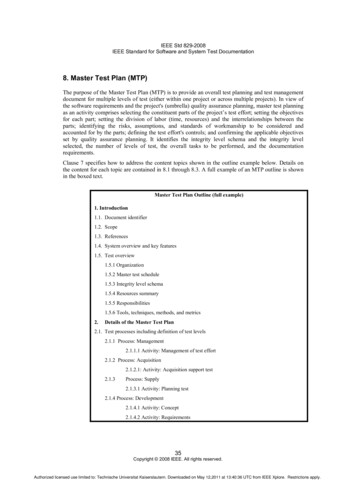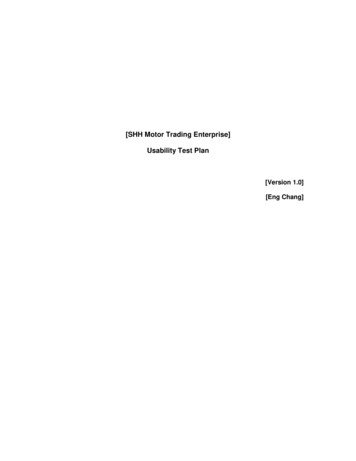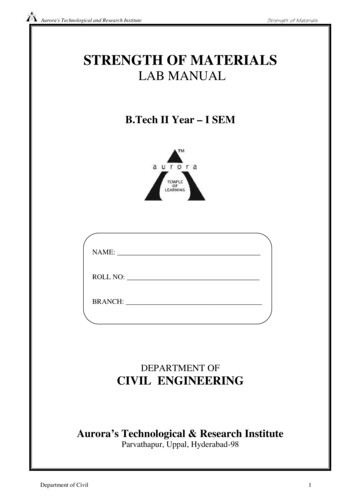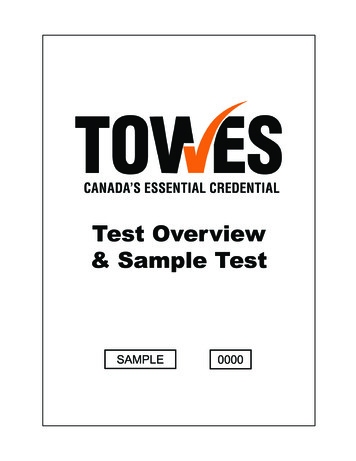
Transcription
Test Plan for RF Performance Evaluation ofWi-Fi Mobile Converged DevicesVersion 2.0.2October 2015 2006-2015 CTIA – The Wireless Association (CTIA) and Wi-Fi Alliance (WFA). All rights reserved.CTIA and WFA have granted a license to Authorized Testing Laboratories, and only to Authorized Testing Laboratories, alimited, nontransferable license to use this Test Plan for the sole purpose of testing wireless devices for their respectiveCertification Programs. Any other use of this Test Plan must be authorized in writing by CTIA and WFA.Any reproduction or transmission of all or part of this Test Plan, in any form or by any means, electronic ormechanical, including photocopying, recording, or via any information storage and retrieval system,without the prior written permission of CTIA and WFA, is unauthorized and strictly prohibited.Any reproduction of this Test Plan shall display the notice: "Copyright by CTIA and Wi-Fi Alliance. All rights reserved."
Certification Program Test PlanCTIA - The Wireless Association1400 16th Street, NWSuite 600Washington, DC 20036Phone: 1.202.785.0081Email: certification@ctia.orgWi-Fi Alliance10900-B Stonelake BoulevardSuite 126Austin, TX 78759Phone: 1.512.498.9434Email: certifications@wi-fi.orgConverged Wireless Group OfficersMichael Foegelle, Co-ChairMichael Montemurro, Co-ChairGarth Hillman, SecretaryAcknowledgments:This test plan was created by the wireless industry with input from the followingcompanies and their eysightMotorola amsungSatimoSGSSpirentTelecommunications Metrology Centerof China Ministry of InformationIndustryUnderwriters LaboratoriesOctober 2015RepresentativeScott Prather, Sungmi ChoiSam Kim, Jae il ChoiMichael Foegelle, Edwin MendivilHassan YaghoobiMoray RumneyPaul Moller, Istvan SziniJody LanesSanjay WadhwaRandy Leenerts,Karthik Babu, AdappaLaxmi, Kevin LiLisa Ward,Christoph Gagern,Thorsten Hertel, Alex TkatchChirag Panchal,James White,Kwangmin Choi, Usman AurakzaiJohn Estrada, Kim Rutkowski,Alessandro ScannaviniJason Bartosch, Nicky (Ho) You,Peter LiaoRonald BorsatoPage 2 of 46Heather GaoEkta BudhbhattiVersion 2.0.2
Certification Program Test PlanChange 6-June-20081.301-June-20092.027-Feb-2015October 2015CommentsDocument Approved Updated Purpose and References sections Clarified text and added footnote in Radiated RF Tests nomenclaturesection Clarified text in Minimum Measurement Distance section Clarified testing conditions for cellular inactive state Corrected step reference in step 14 of Receive Sensitivity Measurement.Removed repeated text. Removed reference to CTIA website for traffic generator softwaredownload Corrected step 1 and clarified language in step 9 regarding antennaconnection in WLAN Access Point Testing Methodology section Removed requirement for OFMD transmit mask test on Mobile Stationsand Access Points Updated WLAN Test Set Estimated Signal Level tables Added Sample Summation test report table Corrected title on Test 5.2.2. and 6.2.2 test report table Added text to clarify that Wi-Fi desense testing is done in free-space only Clarified that cellular desense testing is done in free-space only, and toperform reference measurements if not previously done Removed references to specific test equipment from document 5 GHz TRP, TIS, & Reference Measurement frequency changes – Sections5.1.1.2, 5.1.2.2, 5.2.1.2, 5.2.2.2, Table 5.2 5, 6.1.1.2, 6.1.2.2, 6.2.1.2,6.2.2.2, Table B2 , Table B3, Table B4, Table B5, Table B6, Table B7,New Appendix D Other sections changed: Table B1 - CID Added, section 1.4 - CTIAReference updated, Table A1 Channel change UTRA FDD Band I - IV,4120/824.0 changed to 4132/826.4, Table B3 Reference changed from (2)to (1), Table 5.1.1 and table 6.1.1 - removed "Check Tx Mask" fromcomments column Added footnote to Section 2.1, 2nd sentence. Added text to Section 4.1, 2nd sentence. Added CTIA Request # to Appendix B table. Added Appendix E Device Capabilities Testing Matrix Added 802.11n Added LTE and TD-SCDMA protocols Updated cellular and Wi-Fi desense sections Updated Appendix B Device Capabilities Test Matrix, removed right headand added right and left hand phantoms Added Appendix C – Radio Access Technologies that require testing, butare not covered in the CTIA Test Plan. Added Appendix D - Notebook and Tablet PC Requirements Added Appendix E - WLAN-LTE emulator test equipment notes whentesting EUTs that support LTE band 40 or 41 (Informative)Page 3 of 46Version 2.0.2
Certification Program Test tober 2015Comments Added Appendix F - Table of Wi-Fi Radio channels interfered by cellularradio harmonics Revised Wi-Fi test procedure Sections 3.1, 4.1, 4.2 & 4.3 Updated the Acknowledgements list Updated Section 4.1.3 Measurement Frequencies for Radiated tests Updated Table 2 parameters Split Table 3 to Table 3 and Table 4 for Tx and Rx and also changed Rxparameters Updated Section 2.1 Replaced WLAN with Wi-Fi thought out the document as appropriate Revised Section 4.3.2 to specify PING as the primary mode for packetgeneration Revised Tables 17 and 18 to replace DER with Pass/Fail info onIntermediate Channels Updated title and introduction text of Appendix A Updated Table 12 consistent with the test case requirements of Section 4.6and 4.17 Updated Appendix F to include Wi-Fi desensitization matrix Reference Polarization columns added to all Appendix A tables that includeReference Position information Modified document reference in 5th paragraph of Section 2.2. Updated RAT Channel Number and RAT Uplink Frequency columns inTable 4-5 Updated channel for UNII Low, Middle and Upper Bands in Table A-5 andTable A-6. Deleted first sentence of Appendix A.3. Added text to section 1.6.2. Removed stray text in Table A-2. Fixed cross-references “Draft 1” removed from the footnote Publication and footnote dates updated based on CTIA format Tables A-7 and A-8 modified to include a field for Lab comments onmaximum EIS Modified Section 2.2 to provide explicit guidelines for PING method for802.11n Applied other purely editorial changes to the titles in Appendices sectionsand tables Removed “(WI-FI U-NII MIDDLE BAND)” from the titles and referencesto Channel 60 in Tables A-10 and A-12 Requirement for usage of Hand Phantoms is clarified in Appendix BPage 4 of 46Version 2.0.2
Certification Program Test PlanTable of ContentsSection 1Introduction. 81.1Background . 81.2Scope . 81.3Purpose . 81.4References . 81.5Test Nomenclature Overview . 91.5.1. Conducted RF Tests . 91.5.2. Radiated RF Tests . 91.5.3. Desensitization Tests . 91.6Baseline Methodology . 91.6.1. Measurement Techniques and Test Methodologies . 91.6.2. Measurement Uncertainty . 91.6.3. Minimum Measurement Distance . 91.6.4. Quiet Zone Test Frequencies . 101.7Form Factor Submission for Self-contained Wi-Fi/Mobile Modules . 10Section 2Test Conditions and Device Configuration . 112.1Cellular and Wi-Fi Modes . 112.2Wi-Fi Mode . 11Section 3Conducted Measurements . 133.1Wi-Fi Conducted RF Power Output and Receiver Sensitivity Tests . 133.1.1. Test Purpose . 133.1.2. Test Setup . 133.1.3. Measurement Frequencies and Data Rates for Conducted tests . 133.1.4. Test Procedure for Output Power Level . 143.1.5. Test Procedure for Receiver Sensitivity . 153.1.6. Results . 16Section 4Radiated Measurements . 174.1Wi-Fi Total Radiated Measurements (TRP/TIS) . 174.1.1. Test Purpose . 174.1.2. Test Setup . 174.1.3. Measurement Frequencies for Radiated Tests . 184.1.4. Test Procedure for Total Radiated Power Measurement . 194.1.5. Test Procedure for Total Isotropic Sensitivity Measurement . 194.1.6. TRP Data Rates . 204.1.7. TIS Data Rates . 204.1.8. Results . 204.2Wi-Fi Desense Measurements with Cellular Transmitter ON . 204.2.1. Test Purpose . 204.2.2. Test Setup . 214.2.3. Test Procedures for Wi-Fi Radio Desensitization. 214.2.4. Wi-Fi Radio Desensitization by Closest Cellular Uplink Frequency . 224.2.5. Wi-Fi Radio Desensitization by Cellular Radio Uplink Harmonics . 234.2.6. Results . 264.3Cellular Desense Measurements with Wi-Fi transmitter ON . 264.3.1. Test Purpose . 264.3.2. Test Setup . 264.3.3. Test Procedure for GSM, CDMA and UMTS RATs listed in the CTIA Test Plan . 28October 2015Page 5 of 46Version 2.0.2
Certification Program Test Plan4.3.4. Test Procedure for RATs Listed in Appendix C here and non-LTE RATs listed in the CTIATest Plan Appendix M . 294.3.5. Test Procedure for all LTE cases . 294.3.6. Wi-Fi Frequency . 294.3.7. Error Rate Measure . 304.3.8. Results . 30Appendix A.Summary Test Report. 31A.1.Wi-Fi Conducted Tests . 31A.2.Total Radiated Power (TRP)and Total Isotropic Sensitivity (TIS) for 2.4 GHz 802.11b, 802.11gand 802.11n . 32A.3.Total Radiated Power (TRP) and Total Isotropic Sensitivity (TIS) for 802.11a and 802.11n 32A.4.Wi-Fi Desense Measurements (with cellular transmitter on) . 34A.5.Cellular Desense Measurements (with Wi-Fi transmitter on) . 35Appendix B.Device Testing Configurations . 37Appendix C.Radio Access Technologies that Require Testing, but are not Normative in the CTIATest Plan38C.1 TD-SCDMA. 38C.2 LTE TDD. 38Appendix D.Notebook AND Tablet Requirements . 39D.1Parent/Child Relationships. 39D.2 Parent/Child Antenna Subsystem Considerations. 39D.3 Test configurations and setup procedures . 39Appendix E.Wi-Fi-LTE Emulator Test Equipment Notes when Testing EUTs that Support LTE Band40 or 41 (Informative) . 41Appendix F.Table of Wi-Fi Radio channels interfered by Cellular Radio Harmonics . 43October 2015Page 6 of 46Version 2.0.2
Certification Program Test PlanList of Acronyms and tober 2015AcknowledgeAutomatic Power Save DeliveryCode Division Multiple AccessEffective Isotropic SensitivityEquipment Under TestGlobal System for Mobile communicationLocal Area NetworkLong Term EvolutionMultiple Input Multiple OutputPacket Error RateRadio Access TechnologyReceiveTime Division Synchronous Code Division Multiple AccessTotal Isotropic SensitivityTotal Radiated PowerTransmitUniversal Mobile Telecommunications SystemUMTS Terrestrial Radio Access - Frequency Division DuplexingUMTS Terrestrial Radio Access - Time Division DuplexingWideband Code Division Multiple AccessWireless Local Area NetworkWireless Wide Area NetworkPage 7 of 46Version 2.0.2
Certification Program Test PlanSection 11.1IntroductionBackgroundIncreasingly the wireless market is seeing converged devices that incorporate both cellular and wireless local areanetwork (WLAN or Wi-Fi) functionality. Due to the many potential applications and deployment scenarios thatconverged devices may ultimately function in, operators and device vendors are interested in a uniform and standardway for profiling the RF performance of the devices and associated test methodology. With this standard approach,equipment designers, system operators, and RF engineers have the flexibility to determine their own appropriateRF performance criteria based on their engineering assessments and can easily identify equipment that is suitablefor each deployment and application.1.2ScopeThis test document specifies test methodologies and performance criteria for the RF performance evaluation of WiFi mobile converged devices. The scope of testing includes Handheld, self-contained Wi-Fi/Mobile Module,Access Point, Notebook and Tablet devices that support IEEE 802.11a, 802.11b,802.11g or 802.11n [2] as well ascellular technologies. Support for IEEE 802.11 standards must be confirmed through Wi-Fi Alliance baselinecertification—that is, devices tested using this test plan must first be Wi-Fi CERTIFIED for IEEE 802.11a, 802.11b,802.11g or 802.11n [4]. Cellular technologies include GSM, CDMA, UMTS (WCDMA), LTE and TD-SCDMA.1.3PurposeThe purpose of this document is to define the test methodology for the RF testing of Wi-Fi mobile convergeddevices and to specify the test conditions for each test case. The testing covers client devices and access points andspecifies conducted as well as radiated tests.1.4References[1] “Test Plan for Mobile Device Over-the-Air Performance/Method of Measurement for Radiated RF Powerand Receiver Performance”, latest revision, CTIA vicecertification/certification-test-plans[2] “IEEE Std. 802.11-2012 IEEE Standard for Information technology--Telecommunications and informationexchange between systems Local and metropolitan area networks--Specific requirements Part 11: WirelessLAN Medium Access Control (MAC) and Physical Layer (PHY) Specifications”, .html[3] “User Equipment (UE) / Mobile Station (MS) Over The Air (OTA) antenna performance; Conformancetesting (3GPP TS 34.114)”, Latest Revision, 3GPP http://www.3gpp.org/DynaReport/34114.htm[4] Check the product’s Wi-Fi Certificate at http://certifications.www.wifi.org/wbcs certified products.php?lang en[5] RFC 792 “Internet Control Message Protocol”, IETF, September 1981,https://tools.ietf.org/html/rfc792[6] RFC 1122 “Requirements for Internet Hosts – Communication Layers”, IETF, October 1989,https://tools.ietf.org/html/rfc1122October 2015Page 8 of 46Version 2.0.2
Certification Program Test Plan1.51.5.1.Test Nomenclature OverviewConducted RF TestsConducted tests are those RF Tests where the test equipment is connected to the antenna connector of the deviceunder test by co-axial cables. These tests are formulated to measure basic RF performance such as sensitivity andtransmit power.1.5.2.Radiated RF TestsRadiated tests are those RF Tests that are carried out in a test environment which meets the requirements of theCTIA Test Plan [1]. These include Wi-Fi Tx Power (TRP), Wi-Fi Receive Sensitivity (TIS), Wi-Fi Single PointRadiated Measurements, Radiated Receive Sensitivity of Wi-Fi with cellular active, and Radiated ReceiveSensitivity of the cellular radio(s) with Wi-Fi active.1.5.3.Desensitization TestsDesensitization tests measure the impact that the cellular radio, when transmitting, has upon W-Fi reception andvisa-versa. These tests are performed as radiated tests in according to Device Testing Configurations.1.61.6.1.Baseline MethodologyMeasurement Techniques and Test MethodologiesTRP and TIS in cellular mode are defined in both the CTIA Test Plan for Mobile Device Over-the-Air Performance[1] and User Equipment (UE) / Mobile Station (MS) Over The Air (OTA) antenna performance; Conformancetesting (3GPP TS 34.114) [3].This document relies on the measurement techniques and methodologies within the CTIA Test Plan[1] for MobileDevice Over-the-Air Performance (referred to in this document hereafter as “CTIA Test Plan”) developedspecifically for the purposes of measurement of radiated transmit power and sensitivity. The techniques specifiedin the CTIA Test Plan shall be used as the baseline test methodologies for all tests in here, unless otherwise stated.This document contains information to expand the CTIA Test Plan for use with 802.11 a, b, g and n devices. Thesesections are meant to clarify for the user how the CTIA Test Plan can be utilized for Wi-Fi enabled convergeddevices.1.6.2.Measurement UncertaintyRefer to CTIA Test Plan Section 7 for the uncertainty budget tables for TRP and TIS. The lab shall report theirestimated measurement uncertainty for both the 2.4 and 5 GHz bands. However, the criteria in Section 7.5 [1] areonly required for the 2.4 GHz band.1.6.3.Minimum Measurement DistanceThis section describes the minimum measurement distance, R, which the Far-Field test site shall provide. Themeasurement distance is defined as the distance from the center of rotation of the EUT to the phase center(alternatively, if not accurately known, the nearest point) of the Measurement Antenna.For Cellular minimum measurement distance, refer to CTIA Test Plan Section 3.1. For Wi-Fi 2.4 GHz band, theminimum measurement distance specification specified for Band 41 shall be used. For Wi-Fi 5 GHz band, theminimum measurement distance is FFS; refer to Sections G.7.4 and G.19.1 of the CTIA Test Plan for moreinformation.October 2015Page 9 of 46Version 2.0.2
Certification Program Test Plan1.6.4.Quiet Zone Test FrequenciesQuiet zone test frequencies shall be measured for the following Wi-Fi bands.1. ISM-band:2. U-NII-band:1.72450 MHz 1MHz (sleeve dipole and loop probe antenna)5500 MHz 1MHz (sleeve dipole and loop probe antenna)Form Factor Submission for Self-contained Wi-Fi/Mobile ModulesThe following two cases are considered regarding the antenna subsystem options and required form factorsubmission for self-contained Wi-Fi/Mobile modules. Also, please refer to Appendix D for Notebook and Tablet.The test results shall include a description and diagram or photograph of the test conditions used for the deviceunder test.CASE 1 with Internal Antenna: If the EUT is a self-contained Wi-Fi/Mobile Module with internal antennas, suchas a PC Card, then the vendor may choose toEitherSupply the EUT together with one of its intended host platforms, e.g., a laptop computer. In this case, thecombination shall then be placed on the turntable and the results sheet shall clearly state the combination that wasused in the measurements.OrTest the Module, on its own, mounted in a holder that orientates the module in the position that represents its normaluse. In this case the results sheet shall clearly state that the test did not include a host device.OrCarry out both tests as above. This is the preferred method, but not mandatory.CASE 2 without Internal Antenna: If the EUT is a self-contained Wi-Fi/Mobile Module without internal antennas,such as an mPCI Card, then the vendor must supply the complete device, which includes the antennas, for testing.No individual module testing is acceptable.October 2015Page 10 of 46Version 2.0.2
Certification Program Test PlanSection 22.1Test Conditions and Device ConfigurationCellular and Wi-Fi ModesThe test methodology requires the device be placed in a standard operational mode. This includes all sensors in thedevice as well as proximity sensors. If it becomes evident that EUT thermal protection mechanisms are preventingWi-Fi and cellular transmitters from maintaining full output power during the course of testing, the test lab shallwork with the OEM to identify a suitable mitigation method.Although recognizing that the use of special test modes would enable more simplified testing and the use of formaltest equipment, the test methodology proposed in this document allows the testing of any Wi-Fi mobile device in amode that is as close as possible to its native operation. However, the methodology does require certain specificbehavior of the device so that the test can be executed. EUT vendors are required to supply instructions for the labto configure the devices as specified in this test plan.All Radiated tests shall be made according to configurations specified in Device Testing Configurations with thedevice oriented as specified in Section A.1.1 or A.1.5 (as appropriate) of the CTIA Test Plan [1], applicable to theWi-Fi mode being tested.2.2Wi-Fi ModeThe EUT is expected to be able to associate with the WLAN tester and stay fixed on the same RF channel for theduration of the test even when the WLAN tester signal appears to be below the sensitivity level of EUT.In this test plan, the PING based method is the primary method for packet generation for UL Power measurementwhile the ACK based method is the fall back option if the EUT does not support the PING method. The PINGmethod is the only method to test the conducted (or radiated) power for the 802.11n mode of an 802.11 device.In the PING based method, the WLAN tester will generate ICMP echo request packets with configurable transmitinterval, payload size and payload type. The ICMP echo request packets are targeted at the EUT's IP stack. TheEUT is expected to answer with a well-defined echo reply packet whose payload is identical to the payload of thecorresponding request. For this method to be usable, the device must conform to RFC 792 [5] and RFC 1122 [6]section 3.2.2.6.In the ACK based method, the WLAN tester will be transmitting data frames addressed to the EUT, and the EUTis expected to be able to respond to all of these data frames with an ACK message.Because 802.11n ACKs are sent in the basic service set (which is in the legacy mode), the 802.11n ACK will besent at 6 Mbps. However, the lowest data rate for 802.11n is 6.5 Mbps. Therefore, PING method is the only methodto test the conducted (or radiated) power for the 802.11n mode of an 802.11 device. In this method, IP trafficmessage will force the EUT to answer and generate defined uplink traffic using an 802.11n data rate.The following EUT settings are required to perform the test: Disable scan mode during testing; scanning for AP/client on other channels must be disabled, If applicable, disable Power Save Mode (Note that the WLAN tester will not support WMM APSD), If applicable, disable the Bluetooth radio during tests, Except for the desense testing, the cellular transmitter in the EUT shall be inactive.October 2015Page 11 of 46Version 2.0.2
Certification Program Test PlanRadiated testing shall be performed on an unmodified device using all active antennas. Conducted tests shall beperformed on each antenna port with the other antenna port(s) properly terminated. If necessary, an equivalentdevice maybe modified to provide conducted access to each antenna port.For all Wi-Fi RATs, including 802.11n, 20 MHz channels are used. 802.11n should be configured for a long guardinterval.October 2015Page 12 of 46Version 2.0.2
Certification Program Test PlanSection 33.13.1.1.Conducted MeasurementsWi-Fi Conducted RF Power Output and Receiver Sensitivity TestsTest PurposeThe purpose of this test is to measure the output power level and receiver sensitivity of the Wi-Fi transceiver in thedevice in the conducted mode.3.1.2.Test SetupThe basic test setup is shown in Figure 3- 1.FIGURE 3- 1. BLOCK DIAGRAM FOR WI-FI CONDUCTED MEASUREMENTPlease note that Figure 3- 1 is intentionally generalized to maximize test equipment design flexibility. A WLANtester may include receiver and access point capability sub modules as well as internally implemented attenuatorsto control transmit and receive power to and from EUT.The EUT shall be provided to the Test Laboratory with the facility to connect directly to the RF test equipment.This may be via an existing antenna connector, or it may be a carefully modified unit to allow such connection. Inthe latter case, it is the responsibility of the supplier of the EUT to ensure that the connection is present and suitable.It is recommended that the conducted measurements be performed inside a shielded environment.A reference measurement shall be made in order to account for the attenuation of the cable used for connectingEUT and WLAN tester, see e.g. Section 4.1.For more information about possible test setup configurations and details, refer to Appendix A of CTIA Test Planfor setup illustrations.3.1.3.Measurement Frequencies and Data Rates for Conducted testsThe measurements shall be performed on the lowest, middle1 and highest channels supported by the device, in eachof the 2.4 GHz and 5 GHz bands, at all data rates specified in Table 3-1 and Table 3-2.1For 5 GHz bands refer to Table 4-1 for the middle channel numbers per sub band.October 2015Page 13 of 46Version 2.0.2
Certification Program Test PlanTABLE 3-1 TX TEST DATA RATES FOR CONDUCTED TESTINGBandModeTx Data Rate (Mbps)2.4GHzIEEE 802.11bIEEE 802.11gIEEE 802.11nIEEE 802.11aIEEE 802.11n1166.566.55GHzTABLE 3-2. RX TEST DATA RATES FOR CONDUCTED TESTINGBandModeRx Data Rate (Mbps)2.4GHzIEEE 802.11bIEEE 802.11gIEEE 802.11nIEEE 802.11aIEEE 802.11n116, 546.5, 656, 546.5,655GHz3.1.4.Test Procedure for Output Power LevelThis test procedure defines the basic me
Laxmi, Kevin Li Rohde&Schwarz Lisa Ward,Christoph Gagern, Thorsten Hertel, Alex Tkatch Samsung Chirag Panchal,James White, Kwangmin Choi, Usman Aurakzai Satimo John Estrada, Kim Rutkowski, Alessandro Scannavini SGS Jason Bartosch, Nicky (Ho) You, Peter Liao S











